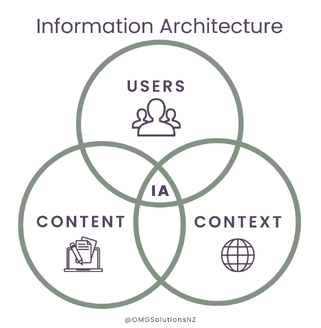A user has have arrived at your website now what?
Imagine walking in to a Theme Park there is no signage around you, they’ve just run out of maps so you’re on your own. As you wonder around the park you get terribly lost, it’s at this point a well-designed map and signage would come in handy to help you quickly orientate, know where you wanted to go and how to get there.
This is the foundation of Information Architecture, it is how we structure and organise information that helps us navigate through complex information to make decisions.
Good Information Architecture is informed by the three areas of Content, Context and User and is crucial in your content marketing strategy. Let’s explore these areas.
User
First up is your user.
Just like content engagement, Information Architecture starts with understanding your audience, or user.
Not only do people look for information in different ways, they react to information differently too so you need to take into account who is using your website. This means knowing your target audience. You need to find out:
Who is going to be consuming your content?
What value is it going to provide them?
What pre-existing expectations do they hold?
Why do they want to engage with you?
Read more Mental Model's - how a user's pre-existing expectations will impact their journey on your website .
It always fascinates me when I ask a client “who is your target audience” and they reply, “it is everyone”.
It can be everyone but I guarantee you, you won’t be able to create a content strategy that suits ‘everyone’ and therefore you’ll miss out on potential customers. It is worthwhile getting to know who you are speaking to.
Content
Within the Information Architecture framework, Content considers:
What kind of information is available
What relevance the content has for the user so it’s not overwhelming
And, how the user finds the information needed without spending hours searching for it.
Read more on Cognitive Load Theory - the brainpower people need to process information and how it impacts on content in website design.
Context
Context looks at where a user is seeking out the content and how they are engaging with it.
With that in mind, consider that users don’t always enter on the home page of your website depending on how your content has been engaged with in the first place.
We need to investigate where users are seeking out our content; is it on social media, a Search Engine, direct from a bookmark, or has it been shared by a friend?
Knowing where a user has come from will determine some of the expectations they have when they land on your website, and help with the structuring of your content and visual layout.
Information Architecture is a valuable tool in a marketer's toolkit
Information Architecture is valuable because it supports the journey your potential customer is taking on your website, it helps them find information they need quickly, it directly impacts lead generation outcomes, it influences the final outcome of engagement and whether a sale is made.
Information Architecture helps the user get to where they need to be. Because unlike a Theme Park, where if you get lost you can find someone to help you, when you are lost online there is no one there to help you to find your way back.
Users need logical, they need orderly, and we need to guide them along the pathway we want them to take. Because chances are, if a user is on your website and they get lost, or the content is not relevant, they will leave.

